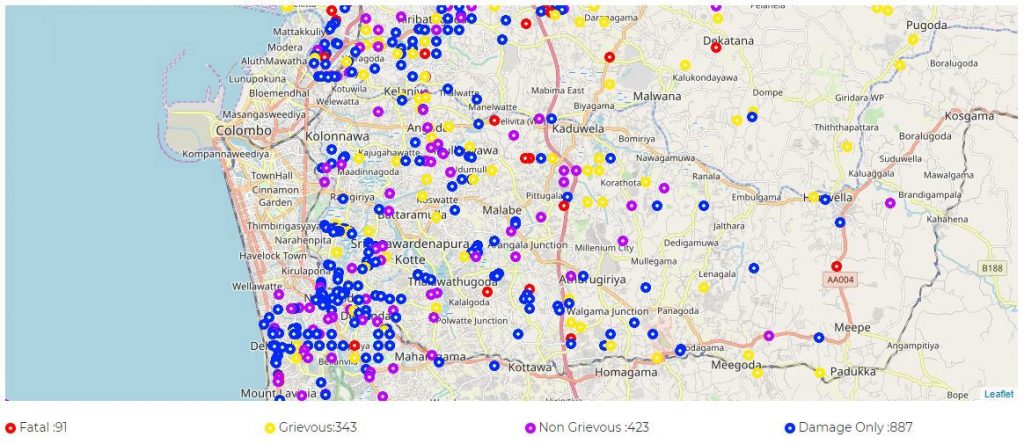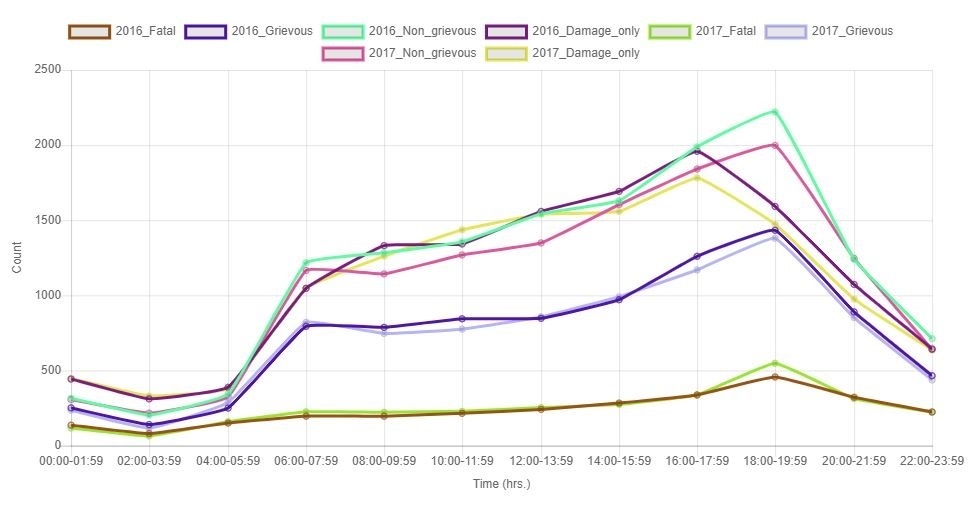Sri Lanka Police collected all the accident data through 297B island-wide. Effective Solutions developed a system to collect e-records and analyze the records statistically would help them to make a proper decision. SLADMS (Sri Lanka Accident Data Management System) is the result of that initiative and it is currently being implemented in the police stations in Western Province.
Goals
This aims to have the number of global deaths and injuries from road traffic crashes by 2020 and to avoid the duplication of work in accident data recording.
Also this is to prevent and to have a reliable information system to address the gaps in management and reporting of road traffic accidents, establish a monitoring mechanism on road safety in order to track situations, progress, performance, and accountability as well as generate analytical information on road traffic crashes that lead to preventive actions.
Economic Problem and Data
The study finds that road traffic injuries kill approximately 3000+ people each year in Sri Lanka and cause an average loss of 50 billion to the national economy every year. For Sri Lanka to successfully achieve the target of reducing road traffic fatalities, it is important to improve the quality, accessibility and sources of road safety data. Death rates from road traffic injuries are high in Sri Lanka. Motorization in Sri Lanka is challenged by the increasing burden of road fatalities. In the country, an average of 8 million motor vehicles and 4 million motorcycles and 2 million three-wheelers who are the main victims of accidents with the current situation, road traffic accidents have been identified as a major threat by the government and non government organizations are paying a key attention to it.
They need a system which provides information in a holistic manner enabling decision makers to make more informed and widespread decisions with regards to road fatalities.
Size of the Problems We Are Facing

Accident Distribution Over the Districts in Sri Lanka (2018)
Solution We Introduced
This accident data management system will generate analytical reports that allow a better understanding of accident patterns of road traffic crashes that lead to preventive actions. As the solution we provide information system to address the gaps in management and reporting of road traffic accidents, establish a monitoring mechanism on road safety in order to track situations, progress, performance, and accountability as well as generate analytical information on road traffic crashes that lead to preventive actions. The solutions can be identified as an artificial intelligence based central intelligence system in communicating road accidents to relevant authorities via this authorities will look at reducing fatal accidents within the country by 50%.
Furthermore, the pattern of road accidents can be identified easily. A data dashboard is an information management tool that can visually track, analyze, display metrics and key data points to monitor the specific process. The dashboard can be customized to meet specific needs.
- Backend, dashboard connects to database services and API’s
- Frontend, it displays all the numerical data in the form of tables, line and bar charts
- Additional developments such as tools for automated black spot identifications, NB-IoT enabled smart alerting, sign boards, progress reports and press releases will provide Sri Lanka the opportunity to maintain a sustainable city and community.
- Cont. improvement updates by considering user feedback
Accident Distribution in Colombo Area
(From 01-09-2018 to 31-12-2018)

Following is an Account of Evidence of Success, and the Key Improvements Based on the Recommendations by the Monitoring Taskforce;
- Timely availability of accurate accident data in the pilot divisions
- Location of the accidents are made more precise in the pilot divisions
- Inclusion of images of the accident site
- Essential accident data in a dashboard
- Auto-generation of analytical reports
- Migration of the road traffic accident data of past 10 years to SLADMS
Migration of the Road Traffic Accident Data of Past 10 Years to SLADMS
(From 01-09-2018 to 31-12-2018)

How to Support the Implementation?
We provide adequate training and introduction to each police force enabling them to understand the gaps in the existing systems and how better to address the current issues via the use of analytical tools provided to each officer. This will aid in better and accurate reporting of road traffic accidents in the country. The system has also enabled the sharing of centralized data within among stations that it is currently operational. Upon implementation of the solution at 4 pilot stations, significant results were seen in a short span of 1 month. A 100% success rate on implementation was observed at these stations with officers also taking on the system with ease. An accurate record of all accidents recorded during the testing phase was noted.
Also, with the SLAMDS accurate reports are generated in less than 24 hours paving the path for quick decision making and accident prevention mechanisms to be implemented and executed.
Testimonials
“The WHO Decade of Action for Road Safety 2011-2020 aims to stabilize and then reduce road traffic fatalities around the world by 2020. Real-time data via SLADMS allows immediate recording of type, status and site of the accident for the Police to respond effectively as well as identify high crash areas and black spots that require special attention.”
– Dr. Razia Pendse, WHO Representative to Sri Lanka
“I would like to state that the implementation of this project has ensured and created a much efficient Police force in Sri Lanka. Sri Lanka has always strived as a nation to bring in digitization to national security efficiently.”
– Mr. Indika Hapugoda, Senior Superintendent of Police, Director/ Traffic Admin and Road Safety, Police Head Quarters
Future of the National System
On the expansion of the current project SLADMS, the Company will focus on digitizing and implementing the solutions to all police stations in Sri Lanka via Q3 of 2021. Whilst doing so the Company will also focus on expanding the system to the South Asian region with the help of WHO. It is a unique product which has to be implemented with the national agency who handles the road safety. Initially the Company will focus on countries such as Bangladesh, Myanmar, Pakistan, Nepal and India which are also faced with the same problem of Accident Management and prevention. The expansion of data gathered via the SLADMS system can also be used by companies such as insurance firms in calculation for premiums, license renewal authorities etc. under the supervision of the police. Enabling them to make better and accurate decisions within their organizations.

